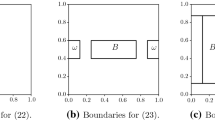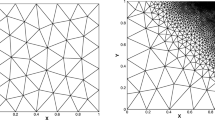Abstract
This study investigates a nonlinear inverse convection problem for a laminar-forced convective flow between two parallel plates. The upper plate is exposed to unknown heat flux while the lower plate is insulated. The unknown heat flux is determined using temperature measured on the lower plate. The thermophysical properties of the fluid are temperature dependent, which renders the problem nonlinear. The sequential gradient method is applied to this nonlinear inverse problem in order to solve the problem efficiently. The function specification method is incorporated to stabilize the sequential estimation. The corresponding adjoint formalism is provided. Accuracy and stability have been examined for the proposed method with test cases. The tendency of deterministic error is investigated for several parameters. Stable solutions are achieved even with severely impaired measurement data.
Similar content being viewed by others
Abbreviations
- C :
-
Volumetric heat capacity
- f :
-
Unknown heat flux
- \(\bar f\) :
-
Unknown heat flux with function specification
- H :
-
Channel height
- J :
-
Residual norm
- k :
-
Thermal conductivity
- L :
-
Channel length
- m :
-
Number of future time steps
- M :
-
Number of time steps
- N :
-
Number of nodal points along duct
- p :
-
Parameter for iterative improvement
- Pe:
-
Peclet number
- R :
-
The total number of repeated estimations using the iterated final condition
- S:
-
Conjugate direction
- t :
-
Time
- t f :
-
Final time
- t i :
-
Final time for each sequence
- t o :
-
Initial time for each sequence
- T :
-
Temperature
- T o :
-
Initial temperature
- T in :
-
Inlet temperature
- u :
-
Velocity, or step function
- U :
-
Mean velocity
- v :
-
Perturbed temperature
- x :
-
Axial distance along channel
- y :
-
Transverse coordinate
- Y :
-
Measured temperature
- β:
-
Step size
- γ:
-
Conjugate coefficient
- Δt :
-
Time step
- Δx :
-
Distance between nodal points alongx− direction
- σ:
-
Standard deviation
- τ:
-
Time variable for solution of adjoint problem
- i :
-
Index
- o :
-
Nominal value
- +:
-
Dimensionless variable
References
Alifanov, O. M., 1994,Inverse Heat Transfer Problem, Springer-Verlag.
Beck, J. V., Blackwell, B. and St. Clair, C. R., Jr., 1985,Inverse Heat Conduction, Wiley.
Chin, Y. D., Hollingsworth, D. K. and Witte, L. C., 1988, “Study of Convection in an Asymmetrically Heated Duct Using Liquid Crystal Thermography,” Proceedings of the 7th AIAA/ASME Joint Thermophysics and Heat Transfer Conference. Part 2, Jun 14–18, 1998, Albuquerque, NM, USA, pp. 63–70.
Dowding, K. J. and Beck, J. V., 1999, “A Sequential Gradient Method for the Inverse Heat Conduction Problems,”Transaction of the ASME, Vol. 121, pp. 300–306.
Flach, G. P. and Özişik, M. N., 1992, “An Adaptive Inverse Heat Conduction Method With Automatic Control,”ASME Trans. J. Heat Transfer, Vol. 114, pp. 5–13.
Huang, C. H. and Özişik, M. N., 1992, “Inverse Problem of Determining Unknown Wall Heat Flux in Laminar Flow through a Parallel Plate Duct,”Numer. Heat Transfer, Part A, Vol. 21, pp. 55–70.
Jarny, Y., Özişik, M. N. and Bardon, J. P., 1991, “A General Optimization Method Using Adjoint Equation for Solving Multidimensional Inverse Heat Conduction,”Int. J. Heat Mass Transfer, Vol. 34, No. 11, pp. 2911–2919.
Li, H. Y. and Yan, W. M., 1999, “Estimation of Wall Heat Flux in an Inverse Convection Problem,”J. Thermophysics, Vol. 13, No. 3, pp. 394–396.
Liu, F. B., and Özişik, M. N., 1996, “Inverse Analysis of Transient Turbulent Forced Convection Inside Parallel Plate Ducts,”Int. J. Heat Mass Transfer, Vol. 39, No. 12, pp. 2615–2618.
Makkawi, Y., Demirel, Y. and Al-Ali, H. H., 1998, “Numerical Analysis of Convection Heat Transfer in a Rectangular Packed Duct with Asymmetric Heating,”Energy Conversion and Management, Vol. 39, pp. 455–463.
McGee, T. D., 1988,Principles and Methods of Temperature Measurement, John Wiley & Sons.
Moutsoglou, A, “An Inverse Convection Problem,” 1989, J. Heat Transfer, Vol. 111, pp. 37–43.
Park, H. M. and Lee, J. H., 1998, “A Method of Solving Inverse Convection Problems By Means Of Mode Reduction,”Chemical Engineering Science, Vol. 53, No. 9, pp. 1731–1744.
Patankar, S. V., 1980,Numerical Heat Transfer and Fluid Flow, Hemisphere.
Reinhart, H. J. and Hao, N. H., 1996, “A Sequential Conjugate Gradient Method for the Stable Numerical Solution to Inverse Heat Conduction Problems,”Inverse Problems in Engineering, Vol. 2, pp. 263–272.
Shah, R. K. and London, A. L., 1978,Laminar flow forced convection in ducts, Advances in Heat Transfer Supplement 1 (Edited by Irvine, Jr., T. F. and Hartnett, J. P.), Academic Press.
Silva, A. J. and Özişik, M. N., 1992, “Two-Dimensional Inverse Heat Conduction Problem of Estimating the Time-Varying Strength of a Heat Source,”J. Appl. phys. Vol. 71, pp. 5357–5362.
Tao, L. N., 1961, “On Some Laminar Forced-Convection Problems,”Journal of Heat Transfer, Vol. 83, pp. 466–472.
IMSL C/Stat/Library. User’s Guide, 1998, Visual Numerics.
Author information
Authors and Affiliations
Corresponding author
Rights and permissions
About this article
Cite this article
Kim, S.K., Lee, W.I. & Lee, J.S. Solving a nonlinear inverse convection problem using the sequential gradient method. KSME International Journal 16, 710–719 (2002). https://doi.org/10.1007/BF03184821
Received:
Revised:
Issue Date:
DOI: https://doi.org/10.1007/BF03184821




